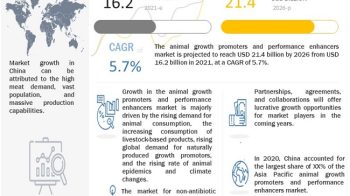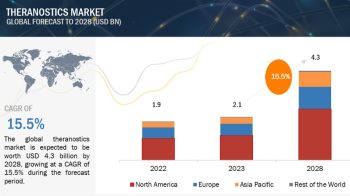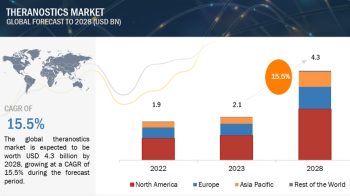The report “Transdermal Drug Delivery System Market by Type (Patches and Semisolid formulations), Applications (Pain Management, Central Nervous System Disorders, Hormonal Applications, Cardiovascular Diseases), End User, and Region – Global Forecast to 2023″, The transdermal drug delivery systems market is expected to reach USD 7.1 billion by 2023 from an estimated USD 5.7 billion in 2018, at a CAGR of 4.5% during the forecast period (2018-2023).
Market growth is largely driven by the global increase in the prevalence of chronic diseases. In addition, technological advancements in transdermal drug delivery systems are also expected to support market growth in the coming years.
The study involved four major activities to estimate the current market size for transdermal drug delivery systems. Exhaustive secondary research was done to collect information about the market, peer markets, and the parent market. The next step was to validate these findings, assumptions, and sizing with industry experts across value chain through primary research. Thirdly, both top-down and bottom-up approaches were employed to estimate the complete market size. Finally, the market breakdown and data triangulation was used to estimate the market size of segments and subsegments.
Download PDF Brochure@
https://www.marketsandmarkets.com/pdfdownloadNew.asp?id=203190114
The transdermal patches segment is expected to grow at the highest CAGR during the forecast period
On the basis of type, the transdermal drug delivery systems market is segmented into transdermal patches and transdermal semisolids. In 2018, the transdermal patches segment is expected to account for the larger share of the transdermal drug delivery systems market. This drug delivery system offers several advantages, such as reduced dosing frequency, improved bioavailability, reduced adverse events, and drug input termination at any point by the removal of the patch. Also, the use of patches results in increased patient compliance due to their non-invasive nature and painless application. These factors are expected to drive market growth.
Market Size Estimation:
Top-down and bottom-up approaches were used to validate the size of the transdermal drug delivery systems market and estimate the size of other dependent submarkets. These methods were also used extensively to estimate the size of various subsegments in the market. The research methodology used to estimate the market size includes the following:
# The key players in the industry and markets have been identified through extensive secondary research.
# The industry’s supply chain and market size, in terms of value, have been determined through primary and secondary research processes.
# All percentage shares, splits, and breakdowns have been determined using secondary sources and verified through primary sources.
The pain management segment is expected to account for the largest share of the market in 2018
On the basis of application, the market is segmented into pain management, central nervous system disorders, hormonal applications, cardiovascular diseases, and other applications (smoking cessation, motion sickness, and overactive bladder treatment). In 2018, the pain management segment is expected to account for the largest share of the transdermal drug delivery systems market. Growth in this market is largely driven by the high burden of chronic pain worldwide and the growing availability of transdermal products for pain management.
Key Questions addressed by the report:
# Which are the key players in the market and how intense is the competition?
# Emerging countries have immense opportunities for the growth of transdermal drug delivery systems market, will this scenario continue?
# Which product market will dominate in future?
# What does the future look like for transdermal drug delivery systems?
# What are the challenges hindering the adoption of transdermal drug delivery systems?
Request Sample Pages@
https://www.marketsandmarkets.com/requestsampleNew.asp?id=203190114
Global Leaders of the Industry:
Hisamitsu Pharmaceutical (Japan), Mylan (US), UCB (Belgium), Novartis (Switzerland), GlaxoSmithKline (UK), Abbvie (US), Boehringer Ingelheim (Germany), Johnson & Johnson (US), Endo International (Ireland), and Purdue Pharma (US) are the major players operating in the global transdermal drug delivery systems market.
These players have adopted various growth strategies, such as product launches and enhancements; agreements, partnerships, mergers, and collaborations; acquisitions; and expansions to strengthen their presence in the global market. Product launches and partnerships have been the most widely adopted strategies by major players from 2015 to 2018. These strategies helped market players to offer innovate products and broaden their customer base.


